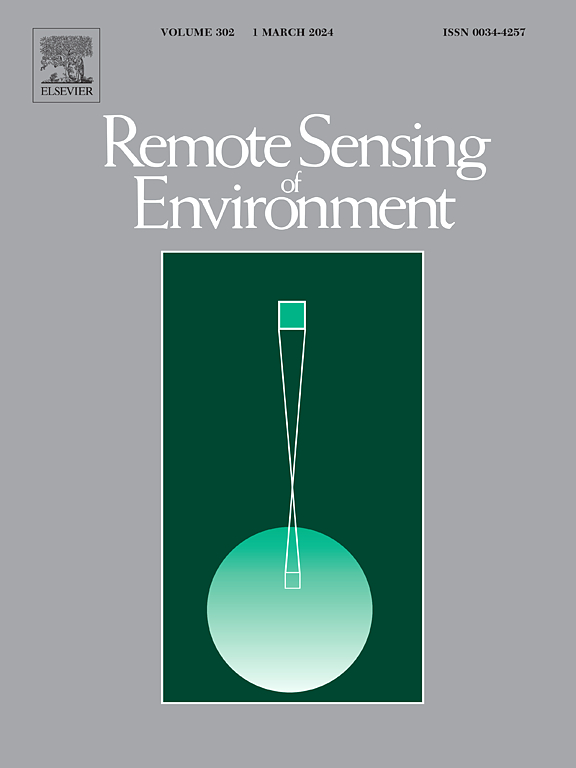DART-based temporal and spatial retrievals of solar-induced chlorophyll fluorescence quantum efficiency from in-situ and airborne crop observations
IF 11.1
1区 地球科学
Q1 ENVIRONMENTAL SCIENCES
引用次数: 0
Abstract
Remotely sensed top-of-the-canopy (TOC) SIF is highly impacted by non-physiological structural and environmental factors that are confounding the photosystems' emitted SIF signal. Our proposed method for scaling TOC SIF down to photosystems' (PSI and PSII) level uses a three-dimensional (3D) modeling approach, capable of accounting physically for the main confounding factors, i.e., SIF scattering and reabsorption within a leaf, by canopy structures, and by the soil beneath. Here, we propose a novel SIF downscaling method that separates the structural component from the functional physiological component of TOC SIF signal by using the 3D Discrete Anisotropic Radiative Transfer (DART) model coupled with the leaf-level fluorescence model Fluspect-CX, and estimates the Fluorescence Quantum Efficiency (FQE) at photosystem level. The method was first applied on in-situ diurnal measurements acquired at the top of the canopy of an alfalfa crop with a near-distance point-measuring FloX system. The retrieved photosystem-level FQE diurnal courses correlated significantly with photosynthetic yield of PSII measured by an active leaf florescence instrument MiniPAM (R = 0.87, R2 = 0.76 before and R = −0.82, R2 = 0.67 after 2.00 pm local time). Diurnal FQE trends of both photosystems jointly were descending from late morning 9.00 am till afternoon 4.00 pm. A slight late-afternoon increase, observed for three days between 4.00 and 7.00 pm, could be attributed to an increase in FQE of PSI that was retrieved separately from PSII. The method was subsequently extended and applied to airborne SIF images acquired with the HyPlant imaging spectrometer over the same alfalfa field. While the input canopy SIF radiance computed by two different methods, i) a spectral fitting method (SFM) and ii) a spectral fitting method neural network (SFMNN), produce broad and irregularly shaped (skewed) histograms (spatial coefficients of variation: CV = 29–35 % and 14–20 %, respectively), the retrieved HyPlant per-pixel FQE estimates formed significantly narrower and regularly bell-shaped near-Gaussian histograms (CV = 27–34 % and 14–17 %, respectively). The achieved spatial homogeneity of resulting FQE maps confirms successful removal of the TOC SIF radiance confounding impacts. Since our method is based on direct matching of measured and physically modelled canopy SIF radiance, simulated by 3D radiative transfer, it is versatile and transferable to other canopy architectures, including structurally complex canopies such as forest stands.
求助全文
约1分钟内获得全文
求助全文
来源期刊

Remote Sensing of Environment
环境科学-成像科学与照相技术
CiteScore
25.10
自引率
8.90%
发文量
455
审稿时长
53 days
期刊介绍:
Remote Sensing of Environment (RSE) serves the Earth observation community by disseminating results on the theory, science, applications, and technology that contribute to advancing the field of remote sensing. With a thoroughly interdisciplinary approach, RSE encompasses terrestrial, oceanic, and atmospheric sensing.
The journal emphasizes biophysical and quantitative approaches to remote sensing at local to global scales, covering a diverse range of applications and techniques.
RSE serves as a vital platform for the exchange of knowledge and advancements in the dynamic field of remote sensing.
 求助内容:
求助内容: 应助结果提醒方式:
应助结果提醒方式:


